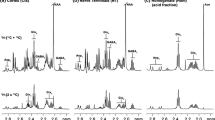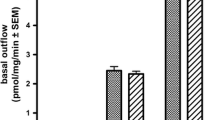Abstract
The effects of L-glutamate and other dicarboxylic amino acids on the accumulation of adenosine 3′,5′-monophosphate (cyclic AMP) in slices of cerebral cortex from strain 2 guinea pigs were examined using tissue from animals at 39 days gestation to 7 days after birth. Responses to glutamate were inhibited completely by adenosine deaminase or theophylline unless histamine was present. When tested in the presence of adenosine, glutamate increased cyclic AMP accumulation up to 10-fold at 39 days gestation; the response was maximal at 52 days gestation, and both the efficacy and potency of glutamate declined thereafter. While the effects of glutamate were smaller in the presence of histamine plus theophylline, the developmental pattern was similar to that in the presence of adenosine. The relative potencies of D-aspartate, kainate, and α-methyl-DL-glutamate were much greater in fetal than in adult tissue. Glutamic acid diethyl ester, N-acetyl glutamate or 2,3-diaminopropionate had no effect in fetal tissue either in the presence or absence of glutamate. Responses to glutamate in adult tissue were much more dependent upon the presence of calcium ions than were those in fetal tissue. It was concluded that responses to glutamate involve mechanisms that differ in fetal and adult tissue.
Similar content being viewed by others
References
Bennett JP Jr, Logan WJ, Synder SH: Amino acids as central nervous transmitters: The influence of ions, amino acid analogues, and ontogeny on transport systems for L-glutamic and L-aspartic acids and glycine into central nervous synaptosomes of the rat. J Neurochem 21:1533–1550, 1973.
Brooker G, Terasaki WL, Price MG: Gammaflow: A completely automated radioimmunoassay system. Science 194:270–276, 1976.
Brostrum CO, Huang Y-C, Breckenridge BM, Wolff OJ: Identification of calcium-binding protein as a calcium-dependent regulator of brain adenylate cyclase. Proc Natl Acad Sci USA 72:64–68, 1975.
Curtis DR, Duggan AW, Felix D, Johnston GAR, Tebecis AK, Watkins JC: Excitation of mammalian central neurones by acidic amino acids. Brain Res 41:283–301, 1972.
Evans RH: Amino acid sensitivity of isolated spinal root fibers from the rat. Br J Pharmacol 70:53P, 1980.
Harper JF, Brooker G: Femtomole sensitive radioimmunoassay for cyclic AMP and cyclic GMP after 2′0 acetylation by acetic anhydride in aqueous solution. J Cyclic Nucleotide Res 1:207–218, 1975.
Heideman W, Wierman BM, Storm DR: GTP is not required for calmodulin stimulation of bovine brain adenylate cyclase. Proc Natl Acad Sci USA 79:1462–1465, 1982.
Himwich WA: Biochemical and neurophysiological development of the brain in the neonatal period. Int Rev Neurobiol 4:117–158, 1962.
Kakiuchi S, Rall TW, McIlwain H: The effect of electrical stimulation upon the accumulation of adenosine 3′,5′-phosphate in isolated cerebral tissue. J Neurochem 16:485–491, 1969.
Lowry OH, Rosebrough NJ, Farr AL, Randall L: Protein measurement with the Folin phenol reagent. J Biol Chem 193:265–275, 1951.
Puil E: S-glutamate: Its interactions with spinal neurons. Brain Res Rev 3:229–322, 1981.
Pull I, Mcllwain H: Actions of neurohumoral agents and cerebral metabolites on output of adenine derivatives from superfused tissues of the brain. J Neurochem 24:695–700, 1975.
Rall TW, Sattin A: Factors influencing the accumulation of cyclic AMP in brain tissue. In: Greengard, P, Costa E (eds). Role of Cyclic AMP in Cell Function, Advances in Biochemical Psychopharmacology, Vol 3. Raven Press, New York, 1970, pp 113–123.
Salter RS, Krinks MH, Klee CB, Neer EJ: Calmodulin activates the isolated catalytic unit of brain adenylate cyclase. J Biol Chem 256:9830–9833, 1981.
Schultz SG, Curran PF: Coupled transport of sodium and organic solutes. Physiol Rev 50:637–718, 1970.
Schwabe U, Meyake M, Ohga Y, Daly JW: 4-(3-cyclopentyloxy-4 methoxyphenyl)-2-pyrrolidone (ZK 62711): A potent inhibitor of adenosine cyclic 3′,5′-monophosphate phosphodiesterases in homogenates and tissue slices from rat brain. Mol Pharmacol 12:900–910, 1976.
Seamon KB, Daly JW: Calmodulin stimulation of adenylate cyclase in rat brain membranes does not require GTP. Life Sci 30:1457–1464, 1982.
Sellinger OZ, Catanzaro R, Chain EB, Pocchiari F: The metabolism of glutamate and aspartate in rat cerebral cortical slices. Proc Roy Soc B 156:148–162, 1962.
Shimizu H, Creveling CR, Daly JW: Cyclic adenosine 3′,5′-monophosphate formation in brain slices: Stimulation by batrachotoxin, ouabain, veratridine, and potassium ions. Mol Pharmacol 6:184–188, 1970.
Shimizu H, Ichishita H, Odagiri H: Stimulated formation of cyclic adenosine 3′:5′-monophosphate by aspartate and glutamate in cerebral cortical slices of guinea pig. J Biol Chem 249:5955–5962, 1974.
Shimizu H, Ichishita H, Umeda I: Inhibition of glutamateelicited accumulation of adenosine cyclic 3′,5′-monophosphate in brain slices by α,w-diaminocarboxylic acids. Mol Pharmacol 11:866–873, 1975.
Shimizu H, Yamamura Y: Effects of diaminopropionate, deoxyadenosine, and theophylline on stimulated formation of cyclic AMP and GMP by depolarizing agents in slices of guinea pig cerebral cortex. J Neurochem 28:383–388, 1977.
Shenk RF, Rall TW: Ontogeny of adenosine 3′,5′-monophosphate metabolism in guinea pig cerebral cortex. I. Development of responses to histamine, norepinephrine and adenosine. Mol Cell Biochem 73:, 1986.
Steiner AL, Parker CW, Kipnis DM: Radioimmunoassay for cyclic nucleotides 1. Preparation of antibodies and iodinated cyclic nucleotides. J Biol Chem 247:1106–1113, 1972.
Watkins JC, Evans RH: Excitatory amino acid transmitters. Ann Rev Pharmacol Toxicol 21:165–204, 1981.
White RO, Neal MJ: The uptake of L-glutamate by the retina. Brain Res 111:79–93, 1976.
Zanella J Jr, Rall TW: Evaluation of electrical pulses and elevated levels of potassium ions as stimulants of cyclic AMP accumulation in guinea pig brain. J Pharmacol Exp Ther 186:241–252, 1973.
Author information
Authors and Affiliations
Rights and permissions
About this article
Cite this article
Rall, T.W., Lehne, R.A. Ontogeny of adenosine 3′,5′-monophosphate metabolism in guinea pig cerebral cortex. Mol Cell Biochem 73, 157–168 (1987). https://doi.org/10.1007/BF00219429
Received:
Issue Date:
DOI: https://doi.org/10.1007/BF00219429




